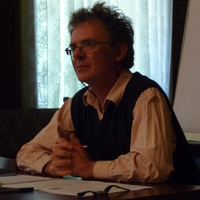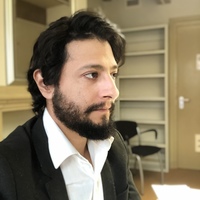
Mehmet Sait Toprak
Prof. Dr. Mehmet Sait TOPRAK
msaittoprak@gmail.com
mehmetsaittoprak@artuklu.edu.tr
Mardin Artuklu University/ Institute of Living Languages
Head of Department of Syriac Language and Culture
Curriculum Vitae
He was born in Muradiye. He has completed his elemantary, middle and high school in Van. In the years 1991 he has graduated Erciş High School and began in the Dokuz Eylul University, Theology Faculty at same year. In this year he has begin his magister education at Dokuz Eylul University/ The Institute of Social Sciences/ Basic Islamic Sciences. And after that became Research Assistant at the Theology Faculty. He has taken his magister [2000] and doctoral [2005] degree from same Institute. He study about Oral Transmission and Oral Culture in relation to Ahadith [Traditions by comparisin to Jewish Oral Tradition. He is specialist on Ottoman Paleography and Epigraphy. He knows English, Syriac, Akkadian, Sumerian, Hebrew, Arabic, Persian, Kurdish and Ottoman Language.
Dissertations
1.Djamali al-Qaramani’s “Risalat fi Atwar al-Suluk” in respect to its Traditions (Magister Degree, 2000)
2. The Beginning of Hadith Compilation Stage and Ushi’s Nisab al-Akhbar (Ph.D. 2005)
Articles
1. Prolegomena To The Problem of Oral Transmission of The Hadıths and The Oral Torah’s Transmission Technique, Review of the Faculty of Divinity, University of Suleyman Demirel, Vol. XX, 2008/1, s. 139-165.
Download article: http://ilahiyat.sdu.edu.tr/docs/dergisayi20.pdf
2. Opposition to the “Kitâbat” in the Hebraic Tradition: Paradox Of The Opposition Of Writing, Review of the Faculty of Divinity University of Dokuz Eylul, Vol. XXV, pp. 127-146, Izmir 2007.
Download article: http://www.deu.edu.tr/UploadedFiles/Birimler/14770/7._MEHMET_SAIT_TOPRAK_127-146_SS_PDF.pdf
3. The Problem of the Hebraic Origin of Opposition to “Writing Down Of the Hadith” in The Islamic Tradition, Review of the Faculty of Divinity, University of Dokuz Eylul, Vol. XXV, pp. 147-175, Izmir 2007.
Download article: http://www.deu.edu.tr/UploadedFiles/Birimler/14770/8._MEHMET_SAIT_TOPRAK_147-175_SS_PDF.pdf
4. Private or Personal Records in Transmission and Preservation of the Hadiths, [in printing stage]
5. Abd al-Aziz al-Ahwani’s The Agenda Books of the Scientist in Andalusia, Review of the Faculty of Divinity University of Dokuz Eylul, Vol. XX, pp. 201-236, İzmir 2004. [Tranlation from Arabic into Turkish with contrubitions].
Download article: http://www.deu.edu.tr/DEUWeb/Icerik/Icerik.php?KOD=6225
6.Seyyit Bey’s The Caliphate and National Sovereignty, The Symposium of A Turkish Jurist and Politician Man Seyyit Bey (16 May 1997), [Transliterated from Ottoman Language into Turkish Latin alphabet] İzmir Theology Faculty Foundation Press, pp. 165-237, İzmir 1999.
7. John F. HEALEY’s The Early History Of The Syriac Script: A Reassessment,Journal of Semitic Studies, XLV/1 Spring 2000, pp. 55-67. Translated from English into Turkish by Mehmet Sait TOPRAK in the Dinbilimleri Akademik Araştırma Dergisi [The Journal of Academical Research of Religious Sciences], Vol: 5, Nu: 4 October / November / December 2005.
Download article: http://www.dinbilimleri.com/dergi/cilt5/sayi4/makale/healey.pdf
8. Cemâlî Ishâq B. Mehmed Al-Qaramânî :Hıs Lıfe And Works, Review of the Faculty of Divinity,
University of Dokuz Eylul, Vol. XXIV, pp. 127-160, İzmir 2006.
Download article: http://www.deu.edu.tr/UploadedFiles/Birimler/13947/XXIV_Yaz-Sonbahar_2006_TELIF_YAZILAR.pdf
9. Ali b. Uthman Siraj al-Din al-Ushi: His Life and Works, Review of the Faculty of Divinity, University of Dokuz Eylul, Vol. XXIII, İzmir 2006, pp. 65-86.
Download article : http://www.deu.edu.tr/UploadedFiles/Birimler/12021/XXIII-2006%20-Telif%20Yazilar.pdf
10. Ali b. Uthman Siraj al-Din al-Ushi and His Contributions to the Science of the Hadith, International Symposium on the Contribution of Turkish World to Islam , Faculty of Divinity, University of Suleyman Demirel Publications, Nu: 20, Isparta 2007, pp. 263-282.
Download article: http://ilahiyat.sdu.edu.tr/Turkler%20Sempozyum/sempozyum%20pdf/3%20oturum%20b%20salon.pdf
11. Charles G. Häberl’s article that entitled “Iranian Scripts for Aramaic Languages: The Origin of the Mandaic Script”, Bulletin of the American Schools of Oriental Research (BASOR) 341 (2/2006). Translated from English into Turkish by Mehmet Sait TOPRAK in the Dinbilimleri Akademik Araştırma Dergisi [The Journal of Academical Research of Religious Sciences],Vol: VIII, Nu: 2 April/May/June 2008.
Download article: http://www.dinbilimleri.com/dergi/cilt8/sayi2/makale/haberl.pdf
12. Latîfî’s Poetic Hundred Hadith Booklet: Subhat al-Ush
msaittoprak@gmail.com
mehmetsaittoprak@artuklu.edu.tr
Mardin Artuklu University/ Institute of Living Languages
Head of Department of Syriac Language and Culture
Curriculum Vitae
He was born in Muradiye. He has completed his elemantary, middle and high school in Van. In the years 1991 he has graduated Erciş High School and began in the Dokuz Eylul University, Theology Faculty at same year. In this year he has begin his magister education at Dokuz Eylul University/ The Institute of Social Sciences/ Basic Islamic Sciences. And after that became Research Assistant at the Theology Faculty. He has taken his magister [2000] and doctoral [2005] degree from same Institute. He study about Oral Transmission and Oral Culture in relation to Ahadith [Traditions by comparisin to Jewish Oral Tradition. He is specialist on Ottoman Paleography and Epigraphy. He knows English, Syriac, Akkadian, Sumerian, Hebrew, Arabic, Persian, Kurdish and Ottoman Language.
Dissertations
1.Djamali al-Qaramani’s “Risalat fi Atwar al-Suluk” in respect to its Traditions (Magister Degree, 2000)
2. The Beginning of Hadith Compilation Stage and Ushi’s Nisab al-Akhbar (Ph.D. 2005)
Articles
1. Prolegomena To The Problem of Oral Transmission of The Hadıths and The Oral Torah’s Transmission Technique, Review of the Faculty of Divinity, University of Suleyman Demirel, Vol. XX, 2008/1, s. 139-165.
Download article: http://ilahiyat.sdu.edu.tr/docs/dergisayi20.pdf
2. Opposition to the “Kitâbat” in the Hebraic Tradition: Paradox Of The Opposition Of Writing, Review of the Faculty of Divinity University of Dokuz Eylul, Vol. XXV, pp. 127-146, Izmir 2007.
Download article: http://www.deu.edu.tr/UploadedFiles/Birimler/14770/7._MEHMET_SAIT_TOPRAK_127-146_SS_PDF.pdf
3. The Problem of the Hebraic Origin of Opposition to “Writing Down Of the Hadith” in The Islamic Tradition, Review of the Faculty of Divinity, University of Dokuz Eylul, Vol. XXV, pp. 147-175, Izmir 2007.
Download article: http://www.deu.edu.tr/UploadedFiles/Birimler/14770/8._MEHMET_SAIT_TOPRAK_147-175_SS_PDF.pdf
4. Private or Personal Records in Transmission and Preservation of the Hadiths, [in printing stage]
5. Abd al-Aziz al-Ahwani’s The Agenda Books of the Scientist in Andalusia, Review of the Faculty of Divinity University of Dokuz Eylul, Vol. XX, pp. 201-236, İzmir 2004. [Tranlation from Arabic into Turkish with contrubitions].
Download article: http://www.deu.edu.tr/DEUWeb/Icerik/Icerik.php?KOD=6225
6.Seyyit Bey’s The Caliphate and National Sovereignty, The Symposium of A Turkish Jurist and Politician Man Seyyit Bey (16 May 1997), [Transliterated from Ottoman Language into Turkish Latin alphabet] İzmir Theology Faculty Foundation Press, pp. 165-237, İzmir 1999.
7. John F. HEALEY’s The Early History Of The Syriac Script: A Reassessment,Journal of Semitic Studies, XLV/1 Spring 2000, pp. 55-67. Translated from English into Turkish by Mehmet Sait TOPRAK in the Dinbilimleri Akademik Araştırma Dergisi [The Journal of Academical Research of Religious Sciences], Vol: 5, Nu: 4 October / November / December 2005.
Download article: http://www.dinbilimleri.com/dergi/cilt5/sayi4/makale/healey.pdf
8. Cemâlî Ishâq B. Mehmed Al-Qaramânî :Hıs Lıfe And Works, Review of the Faculty of Divinity,
University of Dokuz Eylul, Vol. XXIV, pp. 127-160, İzmir 2006.
Download article: http://www.deu.edu.tr/UploadedFiles/Birimler/13947/XXIV_Yaz-Sonbahar_2006_TELIF_YAZILAR.pdf
9. Ali b. Uthman Siraj al-Din al-Ushi: His Life and Works, Review of the Faculty of Divinity, University of Dokuz Eylul, Vol. XXIII, İzmir 2006, pp. 65-86.
Download article : http://www.deu.edu.tr/UploadedFiles/Birimler/12021/XXIII-2006%20-Telif%20Yazilar.pdf
10. Ali b. Uthman Siraj al-Din al-Ushi and His Contributions to the Science of the Hadith, International Symposium on the Contribution of Turkish World to Islam , Faculty of Divinity, University of Suleyman Demirel Publications, Nu: 20, Isparta 2007, pp. 263-282.
Download article: http://ilahiyat.sdu.edu.tr/Turkler%20Sempozyum/sempozyum%20pdf/3%20oturum%20b%20salon.pdf
11. Charles G. Häberl’s article that entitled “Iranian Scripts for Aramaic Languages: The Origin of the Mandaic Script”, Bulletin of the American Schools of Oriental Research (BASOR) 341 (2/2006). Translated from English into Turkish by Mehmet Sait TOPRAK in the Dinbilimleri Akademik Araştırma Dergisi [The Journal of Academical Research of Religious Sciences],Vol: VIII, Nu: 2 April/May/June 2008.
Download article: http://www.dinbilimleri.com/dergi/cilt8/sayi2/makale/haberl.pdf
12. Latîfî’s Poetic Hundred Hadith Booklet: Subhat al-Ush
less
Related Authors
Johannes Zachhuber
University of Oxford
Galen Strawson
The University of Texas at Austin
John Huehnergard
The University of Texas at Austin
Ian Young
Australian Catholic University
Na'ama Pat-El
The University of Texas at Austin
Ahmad Al-Jallad
Universiteit Leiden
Don Ross
University College Cork
Armando Salvatore
McGill University
Sean W . Anthony
Ohio State University
Alejandra B Osorio
Wellesley College
InterestsView All (38)










Uploads
Papers by Mehmet Sait Toprak
In this study, firstly, Abd al-Ghani al-Nablusi’s most important and uniquie manuscript so-called Bazl al-ihsan fi tahqîqi mana’l-insân is edited, critiqued re-viewed, annoted and translated from Arabic into Turkish. It is aimed in this study to bring out like hidden and short booklet from the shelf of the library and submit it to the eyes and minds of scholars.
This article holds the feature of being a ‘theo-linguistic’ essay on dealing with the etymology of the name ‘Yusuf’ in Arabic, ‘Yosef’ in Hebrew and ‘Yawsef’ in Aramaic through linguistic tools in a multidisciplinary way. In this respect, we believe that the attempt to determine the real etymological origin of the name ‘Joseph’ in the light of the available data in the context of ‘Prosopography’ research field concerning names of people and/or ‘who is who in history’ and to examine this particular name in detail as an anthroponym in terms of ‘Onomastic’ will provide an important scientific contribution and value to chronology of Holy Scriptures and their research (Tanakh, Gospels, Qur’an). In this particular, the Egyptian dynasties of the anthroponyms of Joseph, naming traditions in this period, the relationship of the Joseph prophet with the rulers and his activeness and effectiveness in this way will be discussed in the light of the data provided by Linguistics, History, Archeology, Theology and Mythology. We believe that the clues we will put forward through questioning how and under which conditions the name ‘Joseph’ stated in Holy Books and in general all the other names in those books were registered by clerks will hold the possibility of presenting naming conventions. In the light of the data we have built and the pedestals we have built based on them, we think that the names / names given to these Biblical-New Testament-Qur'anic personalities can provide important data in determining the period in which they lived and who they were in the real time. Besides, as it can be seen we hope to prove and demonstrate the naming and naming tradition in the Bible, known as special names, is intended to create, construct and construct a number of historical perceptions with the help of individual names in the context of 'events-fictions' and to make them stronger with mythological elements. We hope that the establishment of a special Onomastics Science in the books that are considered sacred, specially addressing individual names / personalities, will make an important contribution to the indigeneousness of these Biblical person(alitie)s. We think that it would be more appropriate for scientific purposes to maintain an ‘etymological’ research on the basis of ethnic identity or how one calls himself and to make determinations in ‘toponym’ made in the evaluations regarding the ethnic origin of the name ‘Joseph’.
Keywords
Iu, Yu, Yo, Yaw, Sif, Sef, Suf, Seph, Zeph, Zaph, Iusif, Yosef, Yawsef, Joseph, Ṣafnaṯ Paᶜnêaḫ, Ṣofnaṯ Paᶜnêaḫ, TṢafnaṯ Paᶜnêaḫ, Zafnaṯ Paᶜnêaḫ Psonthomphanēch, Etymology, Egypt, Exodus, Hyksos, Tanakh, New Testament Books, Qur’an, Prosopography, Onomastics, Toponomy, Ethnonym, Anthroponym.
Keywords: Eliya Bar Shinaya, Kᵊtobo dᵊ-Targᵊmono, Lexicograpy, Syriac Lexicology.
In this study, firstly, Abd al-Ghani al-Nablusi’s most important and uniquie manuscript so-called Bazl al-ihsan fi tahqîqi mana’l-insân is edited, critiqued re-viewed, annoted and translated from Arabic into Turkish. It is aimed in this study to bring out like hidden and short booklet from the shelf of the library and submit it to the eyes and minds of scholars.
This article holds the feature of being a ‘theo-linguistic’ essay on dealing with the etymology of the name ‘Yusuf’ in Arabic, ‘Yosef’ in Hebrew and ‘Yawsef’ in Aramaic through linguistic tools in a multidisciplinary way. In this respect, we believe that the attempt to determine the real etymological origin of the name ‘Joseph’ in the light of the available data in the context of ‘Prosopography’ research field concerning names of people and/or ‘who is who in history’ and to examine this particular name in detail as an anthroponym in terms of ‘Onomastic’ will provide an important scientific contribution and value to chronology of Holy Scriptures and their research (Tanakh, Gospels, Qur’an). In this particular, the Egyptian dynasties of the anthroponyms of Joseph, naming traditions in this period, the relationship of the Joseph prophet with the rulers and his activeness and effectiveness in this way will be discussed in the light of the data provided by Linguistics, History, Archeology, Theology and Mythology. We believe that the clues we will put forward through questioning how and under which conditions the name ‘Joseph’ stated in Holy Books and in general all the other names in those books were registered by clerks will hold the possibility of presenting naming conventions. In the light of the data we have built and the pedestals we have built based on them, we think that the names / names given to these Biblical-New Testament-Qur'anic personalities can provide important data in determining the period in which they lived and who they were in the real time. Besides, as it can be seen we hope to prove and demonstrate the naming and naming tradition in the Bible, known as special names, is intended to create, construct and construct a number of historical perceptions with the help of individual names in the context of 'events-fictions' and to make them stronger with mythological elements. We hope that the establishment of a special Onomastics Science in the books that are considered sacred, specially addressing individual names / personalities, will make an important contribution to the indigeneousness of these Biblical person(alitie)s. We think that it would be more appropriate for scientific purposes to maintain an ‘etymological’ research on the basis of ethnic identity or how one calls himself and to make determinations in ‘toponym’ made in the evaluations regarding the ethnic origin of the name ‘Joseph’.
Keywords
Iu, Yu, Yo, Yaw, Sif, Sef, Suf, Seph, Zeph, Zaph, Iusif, Yosef, Yawsef, Joseph, Ṣafnaṯ Paᶜnêaḫ, Ṣofnaṯ Paᶜnêaḫ, TṢafnaṯ Paᶜnêaḫ, Zafnaṯ Paᶜnêaḫ Psonthomphanēch, Etymology, Egypt, Exodus, Hyksos, Tanakh, New Testament Books, Qur’an, Prosopography, Onomastics, Toponomy, Ethnonym, Anthroponym.
Keywords: Eliya Bar Shinaya, Kᵊtobo dᵊ-Targᵊmono, Lexicograpy, Syriac Lexicology.
Translator: Mehmet Sait Toprak, İzmir 2005
Karşınızdaki bu çalışma, Hadis Külliyatı’nın Talmud Literatürü ile uygun karşılaştırmalı çalışmalar yapılabileceği, yeni yöntemlerle diğer bilim dallarının (Mitoloji, Arkeoloji, Antropoloji, Astronomi, Tıp, Dilbilim, Narratoloji, Hermenötik vd.) verilerinin bu çalışmalarda kullanılabileceği hatta kullanılması gerektiği savını ortaya atmaktadır. Çalışma, ayrıca rivâyetlerin Tannalarca ikil isnadla aktarılmasının, râvî tabakalarının Hz. Musa’ya kadar dayandırılmasının, Hadiste rivâyetin râvi zincirinin sırf sahih senedlere sahip olmasının, otorite yazarların kanonikleştirilmiş kitaplarında ve tartışmalarında yer almasının, belli bir ulema sınıfının (sözgelimi Ferisi, Sadukî, Esseni, Elkesai, Nasıralı, Markioncu, Aryusçu, Ebionitler, Ehl-i Sünnet, Şia, Mutezile) bu ikincil kaynaklara dair yorumlarının bilimsel yöntemlerle karşılıklı ve karşılaştırılmalı olarak yeniden ele alınmasını önermektedir. Yahudilik ve Hıristiyanlık Araştırmalarının ana kaynaklarıyla, İslam Araştırmaları ve temel kaynakları ile birlikte değerlendirilmesi veya İslam Araştırmaları’nın temel birincil kaynakları ile Yahudilik ve Hıristiyanlık Araştırmaları ve asıl kaynaklarının karşılaştırmalı ele alınması ve bunların insan ve sosyal bilimlerinin verilerinden destek alınarak yorumlanmasının yararlı yeni bir Teo-histo-sosyo-linguistik bir bakış açısını ve anlam(ay)ı tetikleyeceği ve mevcut dogmatik bakışla gelişen tıkanıklıkları gidereceği açıktır. İbranî gelenek ile İslamî geleneğin “isnâd”a dair uygulamalarının üstünlük, öncelik, yeganelikleri üzerine yapılan tartışmaların ve serd edilen mülahazaların neredeyse tamamının ilk el İbranî kaynaklara dayalı olarak yapılmadığı, hatta Müslüman muhaddislerce “İsnadın İslam ümmetine has bir müessese” olduğu şeklindeki anlayışın gereğinden fazla abartılmış bir ibâre olduğunu, ‘İsnad’ın süreçsel gelişimi ve profesyonel hal almasına vurgu yapılmadığı kaynaklarda göze çarpan önemli bir husustur. Halbuki “İsnad” uygulamasının Antik Yunan’da, Çin’de, Hint’te, İran’da, Andenlerde vd. binlerce yıldan beri kadim milletlerin “geleneklerini, tarihlerini ve toplumsal bellekleri”ni taşıdıkları bir “müessese” olduğu ve bunun insanlığın bir “ortak” buluşu belki de belleğin gereği olduğu gözardı edilmiş gözükmektedir.
Semitik din bilginleri sınıfı ( a=Rabbinik Hahamlar, b=Havariler-Pavlus-Kilise Babaları, c= Sahâbe, ᵓEimme-Ulemâ, Ehl-i Sünnet), aMiqrâ-bSᵊbarto-cQur’ân üçlüsünün yanına belki de karşısına herbirinin (a) ikili-ikincisi-ikizi-tekrarlaması olacak bir Sözlü Miqra ‘Torah şe-be-ᶜalpeh’/Mişna’yı, (b) sadece kendisi Müjde olan İsa’ya sözlü dolaşık rivayetlerden müteşekkil İncilleri Kilise’nin keyfi kabulü ile izafe etmek ve ondan sonra İsa ile hiç karşılaşmayan Pavlus’un mektuplarını, ‘Yeni Ahid Külliyatı’nı ve ardından Kilise Babaları’nın oluşturduğu kanonlarını, (c) Qur’ân’ı ‘vahy-i metlûvv’, Sünnet’i ise ‘vahy-i gayri metlûvv’ olarak görüp, ikincil bir kaynak olarak yazıyla kayıt altına alarak ihdâs edilen Hadis literatürünü oluşturmuşlardır. Oluşturulan bu külliyat (aMişna-Talmud, bYeni Ahid Külliyatı, cHadis Mecmuaları) ve etraflarında oluşan otorite yorum(lama)lar, aMiqrâ-bSᵊbarto-cQur’ân üçlüsünü gölgede bırakmışlardır. Bu yönüyle elinizdeki yapıt bilim dünyasında her iki geleneğin ana kaynaklarını orijinal dilleriyle inceleyerek Talmud ve Hadis literatürünü karşılaştırmalı ve kapsamlı bir şekilde ele alan ilk ve tek çalışmadır.
In the beginnings of the fifth year of the Hegira, works on textual hadith collec-tions had a different nature from those produced in the first century. The objective of the works produced in the compilation stage was not only to classify and compile them into a book by receiving the Prophetic traditions from transmitters in accord with the principles of transmittion system, but also to work on them, give them practical accessibility and value, and attain the highest available level of profit from them.
It is well known that hadith and tradition (Sunnah), as a source of knowledge, had a practical value in the age of the Prophet. During that age, there has been no systemati-cal value limitation or classification for knowledge. Within this context, hadith formed the important part of religious knowledge, and was considered of value that should be ap-plied to the daily life, both for individuals and for society.
In order to take into account the practical results of this study, we have edited and criticized Nisāb al-Akhbār li-Tazkirat al-Akhyār written by Siraj al-Din Ali b. Uthmān al-Ushī (d. 575/1179), and in addition to this, we have also evaluated its sources from the methodical point of view. This work consists of 1000 hadiths; each had a symbolic name, compiled from 15 sources and were introduced under 100 subject-matters, consisting of 10 hadiths each.
Needless to say that this work is one of great importance to give us a clear under-standing of the textual hadith collections in which compilation stage. We can say that it will also help us to analyze the historical context in which this literature was produced.